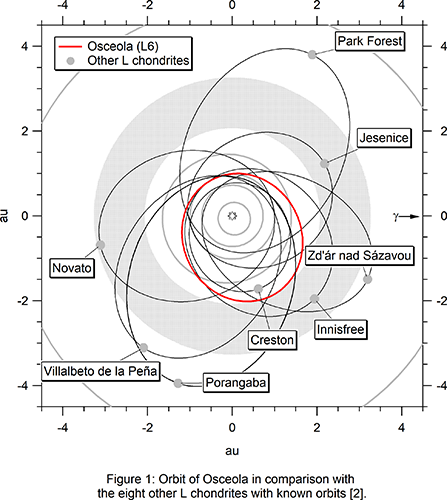Orbit, Meteoroid Size and Cosmic History of the Osceola (L6) Meteorite
- 1Naturmuseum St. Gallen, St. Gallen, Switzerland (matthias.meier@naturmuseumsg.ch)
- 2ETH Zurich, Institute of Geochemistry and Petrology, Zurich, Switzerland
- 3Finnish Geospatial Research Institute, Masala, Finland
- 4Finnish Fireball Network, Helsinki, Finland
- 5Institute of Physics and Technology, Ural Federal University, Ekaterinburg, Russia
- 6Space Science Laboratory, University of California, Berkeley CA, United States of America
Introduction: On January 24th, 2016, 15:27 UTC, a bright daytime fireball was observed in Florida and registered by weather radar and a dash-board camera. Eight fusion-crusted stones with a total mass of 1.1 kg were found [1]. Osceola is now the 33rd meteorite (and the 9th L chondrite) with a published orbit [2].
Methods. Orbit. The atmospheric trajectory was reconstructed based on a dash-cam video recording with account for atmospheric conditions, using the methods described in [3,4]. The orbit (a=1.486 au; e=0.3406, i=13.20°, W=303.9°, w=169.0) was calculated based on this trajectory with the open source software Meteor Toolkit [5]. Noble gases. Four chips (total mass = 118.2 mg) were analyzed at ETH Zurich after problems were encountered during the analysis of the first two chips. Pending detailed analysis, we only report here the results for the second two chips (Os-3 and Os-4). Extraction was done by total fusion in a single temperature step (Table 1), and each measurement was bracketed by blanks. We measured 3,4He, 20,21,22Ne, 36,38,40Ar, 84Kr, 129,132Xe and some potentially interfering (isobaric) species [6]. We calculate meteoroid radius, shielding depth and cosmic-ray exposure (CRE) ages using [7,8] and the bulk chemistry for L chondrites given therein. Radiogenic gas retention (RGR) ages are based on typical abundances of 0.013, 0.043, 825 ppm adopted for U, Th, K, respectively [9]. Cosmogenic radionuclides. Results are forthcoming and will be presented and discussed at the conference.

Results & Discussion. Orbit. The aphelion of Osceola’s barely Earth-crossing orbit is located just inside the inner edge of the asteroid belt, at ca. 2 au, i.e. the orbit is dynamically evolved (Figure 1). In that respect, it is comparable, among L chondrites, only to Creston [10]. Noble gas inventory. Unsurprising for an equilibrated L chondrite, the noble gases in Osceola are cosmogenic and radiogenic for He and Ne, with only minor trapped Ar, and Q-like 84Kr/36Ar, 132Xe/36Ar. Meteoroid size and cosmic history. The cosmogenic 22Ne/21Ne ratio of ~1.07 in both chips suggests irradiation in a meteoroid with a radius >50 cm, at a depth of >40 cm [7], consistent with the size estimate based on the fireball deceleration using the mass calculation method detailed in [11]. Under these shielding conditions, we expect a cosmogenic 3He/21Ne ratio of ~4.5, which fits well with the values measured in Os-3 and -4 (4.60 and 4.40), suggesting no significant loss of He relative to Ne during cosmic-ray exposure. Using 22Ne/21Ne-based production rates from [8], 3He and 21Ne in both chips give a consistent CRE age o 18±2 Ma, while 38Ar yields ~22 Ma. The former is our preferred age, since 38Ar can be more affected by sample inhomogeneities (i.e., distribution of Ca, which is the primary target for production of 38Ar) than 3He and 21Ne. This CRE age does not fall on any prominent peak in the CRE-age-histogram of the L chondrites (e.g., [12]). The CRE age is compatible with the expected collisional lifetime of a R >50 cm meteoroid in the asteroid belt (>14 Ma [13]). The U,Th-He retention age (4He corrected for the contribution of cosmogenic 4He = ~6 × 3He) of the two chips is 460 and 420 Ma, respectively, close to the age of the L chondrite parent body disruption event ca. 470 Ma ago [14]. Given the uncertainties inherent in these ages, it seems at least plausible that Osceola, like a large fraction of the L chondrites falling today, was affected by this shock event. The K-Ar retention ages for the two chips is are 1.5 and 1.1 Ga. The higher age from the K-Ar system might either be due to a contribution of atmospheric 40Ar (given that the measured 40Ar/36Ar ratios of the two chips are lower than the atmospheric value), or incomplete degassing of radiogenic 40Ar during the shock event 470 Ma ago. Dissimilar shock-degassing patterns for the U,Th-He and K-Ar systems are frequently observed for meteorites with shock stages S3 and S4 [15], consistent with the shock classification of Osceola of S4 [1].
Table 1: He, Ne, Ar in Osceola
| Chip (mg) | 3He=3Hecos | 4He | 20Ne | 21Ne | 22Ne | 36Ar | 38Ar | 40Ar = 40Arrad | 4Herad | 21Necos | 38Arcos |
| Os-3 (21.5) | 34.9 | 342 | 7.20 | 7.58 | 8.21 | 4.39 | 2.04 | 714 | 133 | 7.58 | 1.38 |
| Os-4 (15.8) | 35.9 | 337 | 7.00 | 8.18 | 8.73 | 3.55 | 2.11 | 498 | 122 | 8.18 | 1.64 |
References. [1] Bouvier et al., 2017, M&PS 52:2411. [2] www.meteoriteorbits.info, acc. 7.3.20. [3] Lyytinen & Gritsevich, 2016, Proc. Int. Meteor Conf., 159-163. [4] Lyytinen & Gritsevich, 2016, Planet. Space Sci. 120:35. [5] Dmitriev et al., 2015, Planet. Space Sci. 117:223. [6] Meier et al., 2017, M&PS 52:1561. [7] Leya & Masarik, 2009, M&PS 44:1061. [8] Dalcher et al., 2013, M&PS 48:1841. [9] Wasson & Kallemeyn, 1988, Phil. Trans. Roy. Soc. 325:535. [10] Jenniskens et al., 2019 M&PS 54:699. [11] Gritsevich, 2009, Adv. Space Res. 44:323. [12] Marti & Graf, 1992, Ann. Rev. Earth Planet. Sci. 20:221. [13] Farinella et al., 1998, Icarus 132:378. [14] Korochantseva et al., 2007 M&PS 42:113. [15] Stöffler et al., 1991 Geochim. Cosmochim. Acta 55:3845.
How to cite: Meier, M. M. M., Gritsevich, M., Welten, K. C., Lyytinen, E., Plant, A. A., Maden, C., and Busemann, H.: Orbit, Meteoroid Size and Cosmic History of the Osceola (L6) Meteorite, Europlanet Science Congress 2020, online, 21 September–9 Oct 2020, EPSC2020-730, https://doi.org/10.5194/epsc2020-730, 2020

